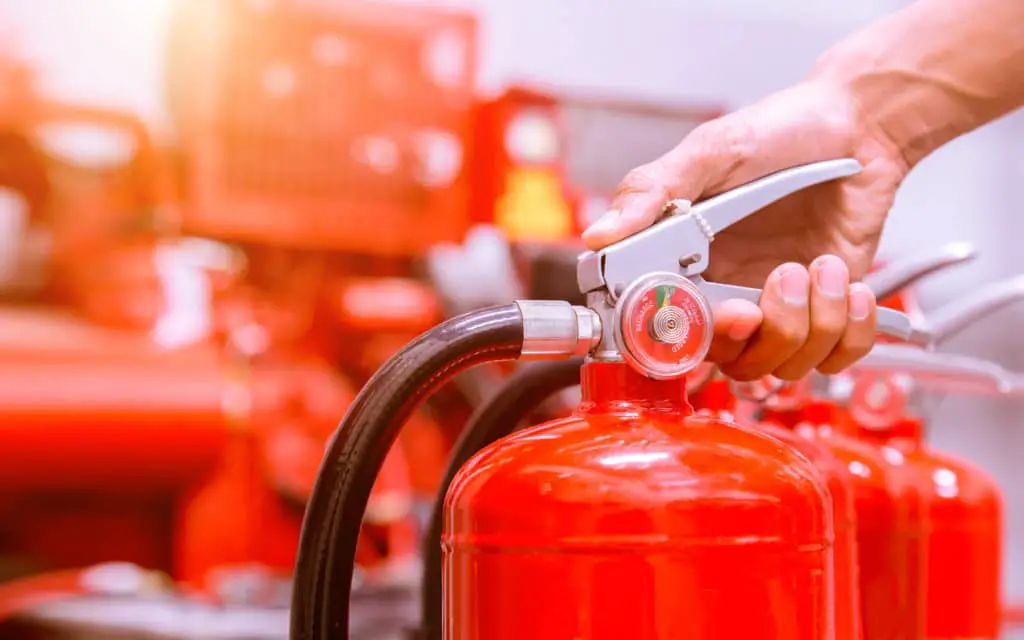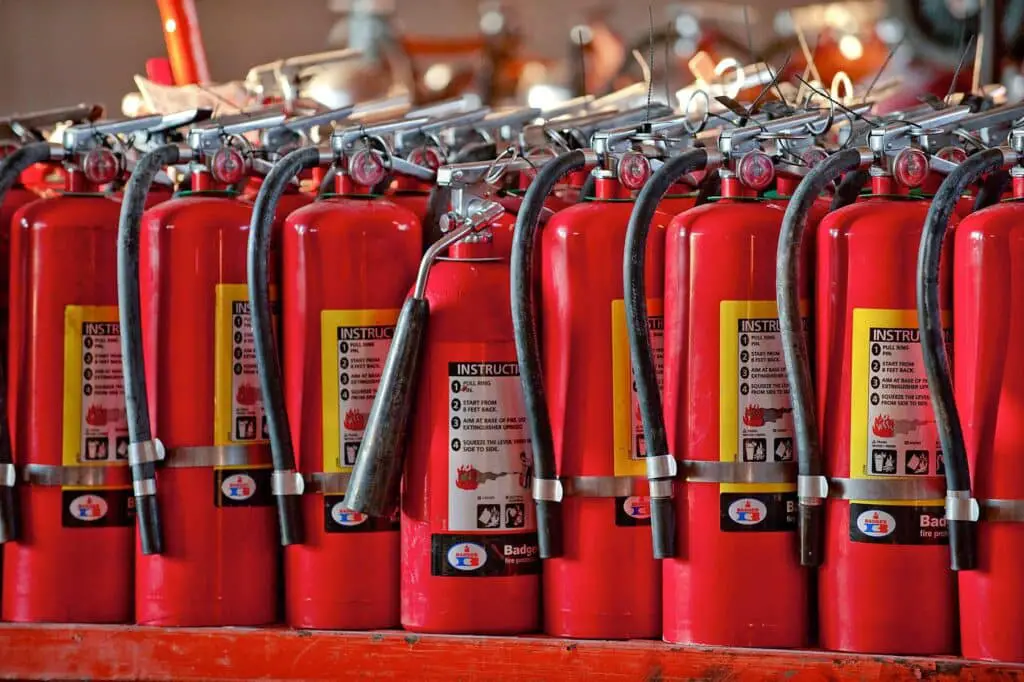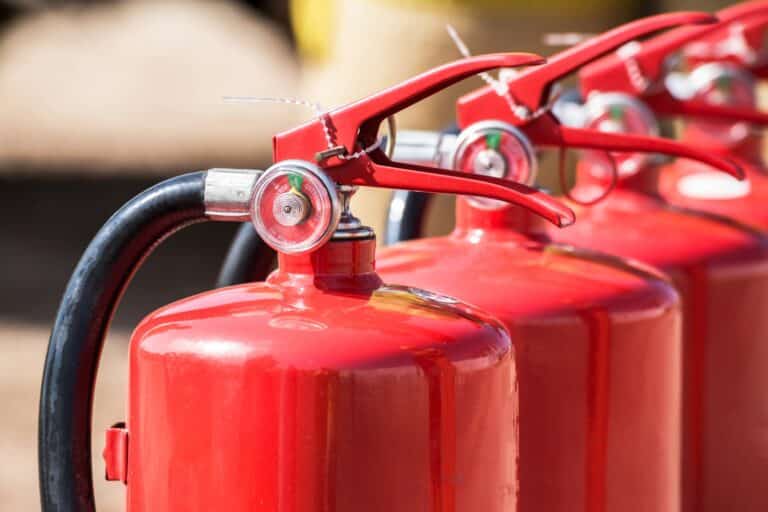Introduction
How Often Should Fire Extinguishers Be Checked: Fire safety, having functioning and accessible fire extinguishers is of utmost importance. These devices act as the first line of defense, allowing individuals to quickly and effectively combat small fires before they escalate into uncontrollable blazes. However, simply installing fire extinguishers is not enough. Regular inspection and maintenance are essential to ensure that these life-saving tools are in proper working condition when emergencies arise.
The frequency of fire extinguisher checks depends on various factors, incorporating industrial standards, local legislation, and extinguisher environment. These examinations thoroughly examine extinguishers for flaws that could affect their performance. Routine checks ensure that your fire extinguishers are ready to use, protecting you and your surroundings.
The importance of regular fire extinguisher checks and explore the recommended inspection intervals based on industry best practices. We’ll also examine the essential elements of a thorough fire extinguisher inspection and what should be checked.

How often should fire extinguishers be inspected?
NFPA 10 requires monthly extinguisher inspections after installation. If extinguishers are installed in rust-prone, impact-prone, or tamper-prone areas, examine them more often.
Regular checkups are needed because fire extinguishers must always be available and functional. An effective fire extinguisher can contain a fire early and prevent it from spreading, limiting damage and saving lives. Missing inspections can cause equipment to malfunction and fail to fight fires, which can be devastating.
The NFPA provides fire extinguisher inspection rules that are extensively used across businesses and countries. Your organization’s certified staff should visually test fire extinguishers weekly per NFPA 10: Standard for Portable Fire Extinguishers. These visual examinations assess the extinguisher’s location, accessibility, and condition for obstructions, damage, or tampering.
In addition to regular visual checks, a competent professional should do an annual maintenance check. This comprehensive fire extinguisher examination tests all its parts to ensure its operation.
The professional will check the extinguisher’s pressure gauge, safety pin, tamper seal, and hose or nozzle during the annual maintenance check. They will also weigh the extinguisher to ensure it fits its weight range. To ensure appropriate operation, the professional will test the pressure and discharge mechanisms.
Some fire extinguishers need more frequent inspections. Manufacturing enterprises, chemical factories, and restaurants may need quarterly or semi-annual fire inspections. Local legislation or insurance requirements may demand more frequent examinations to assure compliance and insurance coverage.
Is annual fire extinguisher inspection enough?
Annual Fire Extinguisher Inspections
NFPA 10 requires qualified fire extinguisher inspectors to execute a full maintenance check every year. A qualified fire protection business must do annual fire extinguisher inspections, unlike monthly ones.
An annual inspection, conducted by a qualified professional, is an in-depth examination of the fire extinguisher’s components, functionality, and overall condition. It involves inspecting the physical integrity of the extinguisher, verifying the pressure gauge, safety pin, tamper seal, hose or nozzle, and conducting tests to ensure proper operation. This thorough inspection helps identify any potential issues or defects that could hinder the extinguisher’s performance.
While an annual inspection is essential, it is important to recognize that a lot can happen within a year that may impact the condition of fire extinguishers. Factors such as environmental conditions, accidental damage, tampering, or changes in fire risks can affect the readiness of extinguishers. By relying solely on annual inspections, there is a risk of undetected issues that could compromise the extinguishers’ functionality, rendering them ineffective during emergencies.
To mitigate these risks, it is advisable to complement annual inspections with more frequent checks. Monthly visual inspections, conducted by trained personnel within your organization, play a critical role in identifying visible signs of damage, obstruction, or tampering. These inspections involve examining the extinguisher’s location, accessibility, and general condition. By performing regular visual checks, potential problems can be identified early on, allowing for timely repairs or replacements.
Why check fire extinguishers regularly?
Fire extinguishers can become damaged over time without you noticing. From old equipment to broken pieces, inspections are important to ensure these aren’t issues moving forward in times of need.
Fire emergencies can occur at any time. You can keep fire extinguishers in good operating order and ready to use by checking them regularly. Regular inspections check the extinguisher’s accessibility, position, and condition for obstructions, damage, or tampering. This makes extinguishers easy to use and maximizes fire suppression.
Fire extinguishers are mechanical devices that require proper maintenance to function reliably. Regular checks help identify any potential issues or defects that could hinder the extinguisher’s performance, such as damaged parts, low pressure levels, or expired extinguishing agents. By addressing these issues promptly, you can ensure that the extinguisher operates effectively when required, minimizing the risk of malfunction during a fire emergency.
Many jurisdictions have specific regulations and standards regarding fire safety and extinguisher maintenance. Regular inspections help ensure compliance with these regulations, avoiding potential penalties or legal liabilities. By adhering to the recommended inspection intervals and documenting the maintenance activities, you can demonstrate a commitment to fire safety and fulfill your obligations as a responsible property owner or business operator.
Weekly fire extinguisher checks?
Portable fire extinguishers need annual expert inspections and monthly visual inspections. Anyone can make brief visual inspections to ensure the extinguisher is fully charged and ready to use.
Weekly inspections ensure that fire extinguishers are always in optimal condition and readily accessible. By checking for any signs of damage, obstruction, or tampering on a weekly basis, you can promptly address any issues that may hinder the extinguishers’ functionality. This increased readiness can significantly improve response times during a fire emergency.
Conducting weekly inspections creates a culture of safety and raises awareness among employees or occupants. Regularly examining fire extinguishers helps individuals become more familiar with their locations, proper usage, and maintenance requirements. It also encourages a proactive approach to fire safety, empowering individuals to report any concerns or malfunctions promptly.
Weekly inspections provide more frequent opportunities to detect potential issues or defects. These regular checks can help identify signs of wear and tear, such as damaged parts, leaking seals, or discharged extinguishers. By detecting these issues early, you can take immediate action, such as scheduling repairs or replacements, ensuring that the fire extinguishers remain fully functional.
In certain industries or jurisdictions, more frequent inspections may be necessary to comply with local regulations or insurance requirements. By conducting weekly inspections, you can demonstrate due diligence in maintaining fire safety standards, potentially reducing liability risks and ensuring compliance with applicable regulations.

What is the validity of fire extinguisher?
How long do fire extinguishers last? The average lifespan of a powder, foam or water extinguisher is usually between 10 and 12 years. This is based on the extinguisher being in good condition with no corrosion or damage. After this time, the fire extinguisher should be replaced with a new one.
Different fire extinguishers have different lifespans. ABC dry chemical, CO2, water, foam, and clean agent (Halon or FM-200) extinguishers are the most frequent. Chemical agents and suppression procedures vary per fire class. The manufacturer evaluates these extinguishers based on chemical stability, degradation rate, and container integrity.
Manufacturers specify fire extinguisher expiration dates. These requirements are usually based on rigorous testing and research to assure extinguisher functionality and dependability. Manufacturer expiration dates should be used to replace extinguishers to ensure their effectiveness.
Fire extinguishers have a shelf life, or the time they may be used when sealed. The manufacturer sets the shelf life, which might be 5 to 15 years depending on the extinguisher. The shelf life indicates the extinguisher’s storage viability, not its lifespan.
Fire extinguishers need regular inspection and evaluation. Professionals check the extinguisher’s condition, pressure, safety features, and wear. Replace any extinguisher that fails maintenance and inspection or shows signs of degradation, regardless of expiration date.
Do all fire extinguishers expire?
Although they don’t have a true “expiration date,” traditional fire extinguishers generally have a 10-12 year life expectancy. Disposable (non-rechargeable) fire extinguishers should be replaced every 10 years.
Types of Fire Extinguishers
Different types of fire extinguishers have varying expiration considerations. The most common types include ABC dry chemical, CO2, water, foam, and clean agent extinguishers. ABC dry chemical, CO2, and water-based extinguishers typically do not have a defined expiration date. However, their viability and effectiveness can diminish over time due to factors such as chemical degradation, container integrity, and loss of pressure.
Maintenance and Inspection
Regular maintenance and inspections play a crucial role in determining the viability of fire extinguishers. During these checks, trained personnel assess the physical condition, pressure levels, safety features, and any signs of damage or wear. Replace any extinguisher that fails maintenance and inspection or shows signs of degradation, regardless of expiration date.
Manufacturer Guideline
Fire extinguisher manufacturers provide guidelines regarding the lifespan and maintenance of their products. These guidelines are based on extensive testing and research to ensure the extinguisher’s optimal functionality and reliability. While some manufacturers specify an expiration date for their products, others may focus on maintenance and inspection requirements without a defined expiration period.
Is fire extinguisher need to refill every year?
You must refill fire extinguishers immediately after each use. No matter how used, extinguishers must be refilled regularly. Such refilling typically takes place every six to twelve years from the manufacture date.
Regular inspections play a crucial role in determining the need for refilling fire extinguishers. Monthly visual inspections help identify any signs of tampering, damage, or leakage that may result in extinguishing agent loss. Additionally, annual maintenance checks by qualified professionals involve a thorough examination of the extinguisher, including checking the pressure levels, safety features, and overall condition. If the pressure is below the specified range or the extinguishing agent is insufficient, a refill or recharge is necessary.
Fire extinguisher manufacturers provide guidelines regarding the maintenance, servicing, and refilling of their products. These guidelines are based on extensive testing and research to ensure the extinguisher’s optimal functionality and reliability. The manufacturer’s recommendations may include specific intervals or criteria for refilling or recharging fire extinguishers. It is important to follow these guidelines to maintain the extinguisher’s effectiveness.
The frequency of refilling fire extinguishers may also depend on the level of fire risk and usage in a particular environment. High-risk environments, such as manufacturing facilities or kitchens, may require more frequent refills due to the potential for more frequent usage or higher fire incidents. Similarly, fire extinguishers located in areas with heavy foot traffic or prone to accidental damage may require more frequent refilling to ensure readiness.
Replace fire extinguishers how often?
Every 12 years
Even in perfect condition, fire extinguishers should be changed every 12 years and refilled every 6. Anyone who lights candles, cooks often or just has matches in the house can benefit from a nearby fire extinguisher. But they are absolute must-haves in certain situations.
Regular maintenance and inspections are crucial in determining the need for fire extinguisher replacement. Monthly visual inspections help identify visible signs of damage, corrosion, or tampering that may compromise the extinguisher’s functionality.
Annual maintenance checks conducted by qualified professionals involve a comprehensive examination of the extinguisher, including checks on the pressure, safety features, and overall condition. If an extinguisher fails maintenance and inspection or shows considerable deterioration, replace it.
Fire extinguisher manufacturers provide guidelines regarding the lifespan and replacement of their products. These guidelines are typically based on extensive testing and research to ensure the extinguisher’s optimal functionality and reliability.
While some manufacturers may provide specific replacement intervals, others may focus more on maintenance and inspection requirements. It is essential to follow the manufacturer’s guidelines to ensure the extinguisher’s effectiveness and compliance with industry standards.
Local regulations and standards may dictate specific requirements for fire extinguisher replacement. These regulations can include guidelines for the replacement timeline, maintenance procedures, and compliance with industry standards. It is crucial to be aware of and comply with these regulations to ensure fire safety and legal compliance.

Conclusion
The frequency of fire extinguisher checks may vary depending on industry guidelines, local regulations, and the specific environment in which they are located. It is crucial to familiarize yourself with the applicable standards and requirements to establish an appropriate inspection schedule. This proactive approach will help identify any potential issues, such as expired extinguishers, damaged parts, or inadequate pressure levels, which could compromise their effectiveness when needed most.
Regular inspections also provide an opportunity to fire extinguisher inspection educate and train individuals on the proper usage and handling of fire extinguishers. Conducting mock drills and offering refresher courses can ensure that everyone is familiar with the equipment and ready to respond swiftly and effectively during an actual fire emergency.
By prioritizing the maintenance and regular checks of fire extinguishers, you contribute to a safer environment for yourself, your family, employees, and visitors. This proactive approach to fire safety not only protects lives but also safeguards property and minimizes the potential for devastating losses.

